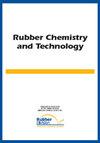可拉伸印刷电子产品用弹性基板的制造
IF 1.5
4区 工程技术
Q4 POLYMER SCIENCE
引用次数: 1
摘要
可拉伸电子产品正被用于可穿戴电子产品、机器人皮肤、可穿戴健康监测设备和智能纺织品等应用,因为它们通过拉伸、弯曲、扭曲和折叠具有优异的机械适应性。这项工作的重点是基于丁基橡胶(IIR),结合铁电填料钛酸锶钡(BST),创造可打印的可拉伸基底。BST具有独特的特性,包括通过向衬底施加偏压来调节介电特性的能力。引入BST的高负载以调整衬底的介电性质。本工作研究了三种不同固化体系对性能的影响,包括与银油墨的相互作用。对于所有固化系统,固化和焦烧时间随着BST负载的增加而减少。酚醛树脂固化不会影响油墨的导电性,而硫固化体系会导致油墨不导电。对于酚醛树脂固化的基材,随着填料负载量的增加,拉伸强度增加,伸长率降低。弹性体可以填充高达40体积%的BST,同时仍然保持大于200%的伸长率。本文章由计算机程序翻译,如有差异,请以英文原文为准。
MANUFACTURING OF ELASTOMERIC SUBSTRATES FOR STRETCHABLE PRINTED ELECTRONICS
Stretchable electronics are being used in applications such as wearable electronics, robotic skin, wearable health-monitoring devices, and smart textiles due to their excellent mechanical conformability through stretching, flexing, twisting, and folding. This work focuses on creating printable stretchable substrates based on butyl rubber (IIR), combined with a ferroelectric filler, barium strontium titanate (BST). BST has unique properties, including the ability to tune the dielectric properties by applying a bias to the substrate. A high loading of BST was incorporated to tailor the dielectric properties of the substrate. This work investigated the effect of three different cure systems on the properties, including interaction with a silver ink. For all cure systems, cure and scorch time decreased with increases in BST loading. A phenolic cure did not affect the ink conductivity, whereas the sulfur-cured systems resulted in nonconductive ink. For the phenolic-cured substrate, the tensile strength increased and the elongation decreased with increasing filler loading. The elastomer could be filled with up to 40 vol. % BST while still maintaining elongation greater than 200%.
求助全文
通过发布文献求助,成功后即可免费获取论文全文。
去求助
来源期刊

Rubber Chemistry and Technology
工程技术-高分子科学
CiteScore
3.50
自引率
20.00%
发文量
21
审稿时长
3.6 months
期刊介绍:
The scope of RC&T covers:
-Chemistry and Properties-
Mechanics-
Materials Science-
Nanocomposites-
Biotechnology-
Rubber Recycling-
Green Technology-
Characterization and Simulation.
Published continuously since 1928, the journal provides the deepest archive of published research in the field. Rubber Chemistry & Technology is read by scientists and engineers in academia, industry and government.
 求助内容:
求助内容: 应助结果提醒方式:
应助结果提醒方式:


